Many of us have fond childhood memories of exploring a backyard creek, splashing in a nearby lake, or catching our first trout in a local stream. These experiences not only engaged us in the outdoors, they educated us about the connections between nature and our community — an education that could not be replicated in a brick-and-mortar school.
Today, an entire generation is growing up with little connection to the natural world. The lack of time spent playing outdoors is taking its toll on the healthy development of our children. Yet at the same time, we are learning that some favorite outdoor spaces can also harbor serious health risks. Given the state of America’s waters, you might actually be glad the kids are staying home.
State and local agencies charged with protecting our nation’s waters face increasing budget deficits and diminishing resources for monitoring waterway health. In fact, less than 20 percent of America’s rivers and streams are being monitored at all. Of the few that are checked, less than half have been found safe for fishing, swimming, and other uses — often based on just one water quality test every five years!
Every American deserves to know whether it’s safe to swim, fish, boat, and hunt in and around neighborhood streams and large rivers.
That’s where you come in.
Just a few hours of your time is all it takes to make sure your neighborhood streams are safe — or find out that they’re not. Share your findings with the League and appropriate state agencies and we can get a clear picture of water quality across the country, which is the first step in crafting water quality solutions that work.
First, it helps to understand the depth of the problem.
Troubled Waters
Streams and wetlands provide habitat for fish and wildlife. They also provide important benefits for people — from flood protection and erosion control to drinking water and opportunities for recreation and education. When we turn on the tap, dip our fishing line in a stream, or take our children and grandchildren to the local swimming hole, we often take for granted that the water is clean and safe. After all, our waters are protected by federal and state laws, right?
The short answer is: Sort of.
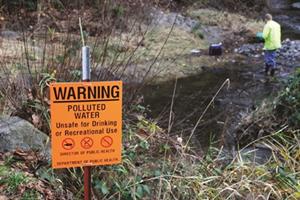 Although the Clean Water Act and other federal and state laws dramatically curbed some types of water pollution, that hasn’t solved all our water quality problems. One reason is that the Clean Water Act focuses primarily on point-source pollution — pollution that comes from a distinct, identifiable source (or “point”). The U.S. Environmental Protection Agency (EPA) and state agencies have had great success in controlling pollution from factories, sewage treatment plants, and other point sources.
Although the Clean Water Act and other federal and state laws dramatically curbed some types of water pollution, that hasn’t solved all our water quality problems. One reason is that the Clean Water Act focuses primarily on point-source pollution — pollution that comes from a distinct, identifiable source (or “point”). The U.S. Environmental Protection Agency (EPA) and state agencies have had great success in controlling pollution from factories, sewage treatment plants, and other point sources.
The threats to water quality today are less obvious than a factory pipe or sewage outflow — but no less harmful.
Today’s threats are the often unseen pollutants carried into waterways by rain, snowmelt, and other runoff, including
- Fertilizers and pesticides from farm lands and suburban lawns
- Motor oil and ice-melting chemicals from parking lots and community streets
- Bacteria from livestock and pet waste
This is called nonpoint-source pollution because it does not come from a single identifiable “point” — which also makes it much harder to eliminate.
The Clean Water Act does not provide effective tools to curb nonpoint-source pollution. Federal programs that address nonpoint-source pollution — including the Nonpoint Source Management Program and the Coastal Nonpoint Pollution Program — have made little progress in stemming the flow of pollutants from nonpoint sources because these programs are voluntary. In addition, the responsibility for regulating nonpoint-source pollution has largely rested on the shoulders of state and local authorities that, as stated earlier, often lack the funding and personnel needed to curb this growing threat.
The Government Accountability Office reported in 2014 that, “More than 40 years after Congress passed the Clean Water Act…many of the nation’s waters are still impaired, and the goals of the Act are not being met. Without changes to the Act’s approach to nonpoint-source pollution, the Act’s goals are likely to remain unfulfilled.”
The solution, then, won’t be found in federal laws or state agencies. In fact, the solution rests with you.
You Can Save America’s Streams
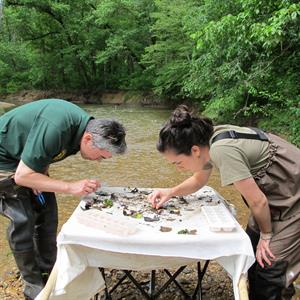 The League was founded by sportsmen concerned about water pollution and its impact on the outdoor pursuits they loved. Since that day in 1922, clean water has been a priority for our organization.
The League was founded by sportsmen concerned about water pollution and its impact on the outdoor pursuits they loved. Since that day in 1922, clean water has been a priority for our organization.
The League was one of the first groups to recognize that with the right tools and training, anyone can collect scientifically valid information about water quality. For more than 45 years, the League’s Save Our Streams (SOS) program has helped volunteers measure and report water quality conditions in their local creeks and streams, making it one of the most successful water-based education and outreach tools in the country.
Using Save Our Streams to record the range of critters that live in local waters, volunteers can provide important information about the health of waterways across the country to the state and local agencies charged with protecting these waters. Volunteer groups can also use this information to plan restoration projects, evaluate their successes, and advocate locally for water quality.
The problem: There are not nearly enough volunteers today to cover the stream miles that crisscross our country.
League members can change this.
You don’t have to do it alone. League staff can walk you through how to get started as a stream monitor and even provide training for you. Plus, this is a perfect way to get your community involved in a League project, with the added benefit of encouraging people to examine how their everyday actions affect waters in their communities.
Insects and Crayfish and Snails . . . Oh My!
The smallest of streams can harbor an astounding variety of beetles, insect larvae, snails, and other aquatic life. These creatures, called macroinvertebrates, can tell us a lot about the health of a body of water.
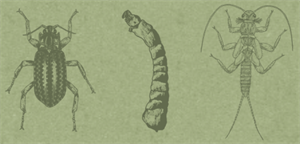 What is a “macroinvertebrate”? An invertebrate is an animal that doesn’t have a backbone, and “macro” means that you don’t need a microscope to see one (although some are still very tiny). Aquatic macroinvertebrates live on, under, and around rocks and sediment on the bottoms of rivers and streams. Unlike fish, frogs, and other stream dwellers that move around, macroinvertebrates tend to stay in one small area all their lives. However, they vary widely in their tolerance for pollution. So the presence — or absence — of certain macroinvertebrates can tell us whether a stream is healthy.
What is a “macroinvertebrate”? An invertebrate is an animal that doesn’t have a backbone, and “macro” means that you don’t need a microscope to see one (although some are still very tiny). Aquatic macroinvertebrates live on, under, and around rocks and sediment on the bottoms of rivers and streams. Unlike fish, frogs, and other stream dwellers that move around, macroinvertebrates tend to stay in one small area all their lives. However, they vary widely in their tolerance for pollution. So the presence — or absence — of certain macroinvertebrates can tell us whether a stream is healthy.
Stream monitors sometimes use the term “bugs” as shorthand for macroinvertebrates, but this group also includes shellfish, crustaceans, and more. Meet some macroinvertebrates and try our quiz.
Save Our Streams measures water quality using the macroinvertebrates found in a stream. These critters are divided into three categories based on their sensitivity to pollution: sensitive, somewhat tolerant, and tolerant. A stream with excellent water quality will be home to an array of macroinvertebrates from all three groups. Streams with poor water quality would contain just a few types and numbers of macroinvertebrates — and mostly the ones that are tolerant of pollution. There are no “bad” bugs. A healthy stream will host a diverse group of stream dwellers.
Getting Your Feet Wet
You don’t need a background in science or a trunk full of complicated equipment to become a volunteer stream monitor. Save Our Streams is easy and inexpensive for volunteers to do.
The League’s Guide to Aquatic Insects and Crustaceans offers step-by-step stream monitoring instructions, from finding the best monitoring spot to tips on positioning your net and collecting critters. Check our stream monitoring equipment list to ensure you hit the water with the tools you need — we’ve listed the basics and the uses for each item.
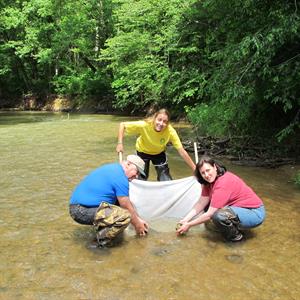 Once you collect a sample of macroinvertebrates, you will sort and identify them, then record the results on a Stream Quality Survey data form. After your count is complete, you should return all critters to the stream to ensure their survival. Other data to collect includes water temperature, physical appearance of the stream, and fish populations — it’s all spelled out on the data form. (The League periodically updates the sensitivity rankings for macroinvertebrates based on the most recent scientific research, so check the Web site for the most recent form before you head out.)
Once you collect a sample of macroinvertebrates, you will sort and identify them, then record the results on a Stream Quality Survey data form. After your count is complete, you should return all critters to the stream to ensure their survival. Other data to collect includes water temperature, physical appearance of the stream, and fish populations — it’s all spelled out on the data form. (The League periodically updates the sensitivity rankings for macroinvertebrates based on the most recent scientific research, so check the Web site for the most recent form before you head out.)
That’s all there is to it! It may take a little practice to hone your bug ID skills, but in no time you’ll be able to tell dobsonfly larva from dragonfly larva. You can also download our Aqua Bugs app to help you identify the macroinvertebrates you find.
A few other steps will help ensure your success:
- Scope the Site: If you are concerned about the impact of a specific land use, such as a construction area, choose monitoring sites just upstream and downstream of that location. If you want to check water quality along an entire stream or pinpoint possible pollution sources, monitor upstream and downstream of each tributary flowing into the stream. If the waterway you want to monitor runs through private land, ask permission to monitor that site.
- Mark Your Station: Monitoring should always be conducted at the same location, also called a station, each time. Record the location by permanent landmarks such as roads and bridges. Better yet, record the longitude and latitude using a GPS unit. This will also help government officials pinpoint the monitoring site — both for record keeping and if you find a problem. If you are monitoring more than one site, space them at least one-quarter mile apart to ensure your monitoring activities at one station do not affect the results at another station.
- Follow the Leader: In addition to the SOS steps you will use, some states have requirements citizens must follow when monitoring water quality. Contact the League’s Clean Water Program Director, at (800) IKE-LINE, to find out whether there is a protocol — a specific set of instructions for stream monitoring — established by your state environmental agency. This might include the types of data your state agency will accept and quality assurance steps you need to take. We can find out what protocol your state has in place and how it fits with the critter hunting you’ll do using Save Our Streams.
- More Is Better . . . But Don’t Overdo It: Because streams and rivers go through seasonal changes, monitor once each season — spring, summer, fall, and winter — as well as two other times during the year. Ideally, the extra two surveys should be conducted after floods, pollution spills, or other significant events that can affect water quality. However, over-monitoring can disturb the stream bed and macroinvertebrate communities, so allow two months between monitoring events for stream critters to “recover.”
Other Signs of Stream Health
If your resources are limited in terms of equipment or manpower, you can still contribute valuable information about local waterways by gathering intel on a stream’s physical health and chemical composition.
- Chemical Check: A store-bought kit allows you to test the chemical components of your stream, including pH, dissolved oxygen, and nutrients. If you test once a month — or even better, once a week — you can get a good sense of the overall water quality. Chemical testing also is valuable if you are looking for something specific, such as tracking fertilizer runoff from suburban lawns or farm fields. You can find chemical testing guidelines and a data form on our Web site. at as well as links to stream monitoring equipment suppliers. Test kits vary widely in cost, ease of use, and levels of accuracy.
- A Full Physical: Download the physical monitoring data form and use it to document information such as erosion, stream bank vegetation, and algae growth. Make note of unusual colors, odors, trash, or other problems and snap a photo to document all the issues. Upload your photos to the League’s Creek Freaks Web site and send the link to your state or county water quality management department. County agencies appreciate having photos and exact locations so they can prioritize problems and send staff out to solve them.
Restoring Communities
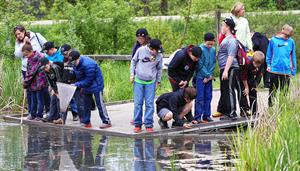
After you have identified a source of water quality problems using the monitoring protocols, the final step is restoration — working to fix whatever is damaging local waterways. It could be as simple as talking with neighbors about using less fertilizer on their lawns and picking up after pets. It could involve repairing an extremely eroded stream bank — and whatever is causing the erosion to occur. Restoration projects big and small can be another great opportunity to bring the community together around a common cause.
The Future Depends on You
It’s a simple fact: government agencies do not have the resources to fix all our nation’s water quality problems. The Izaak Walton League has a proud history of defending our country’s waters. We need your help to do it again. Please consider starting a water quality monitoring group today. Visit the Save Our Streams Web page for all the resources you’ll need. Working together, we can make a real difference in saving outdoor America — and our own communities.